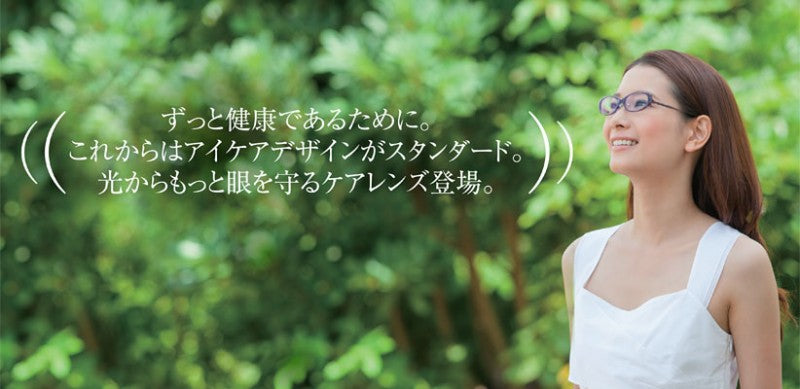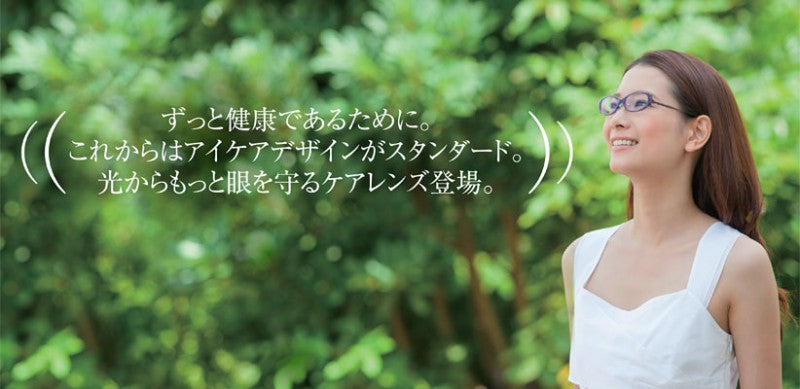
There are many different types of eye diseases that can take away your health. Among these, age-related macular degeneration is one of the most common yet frightening eye diseases. It has been reported that this disease is caused by damage to lutein, a pigment present in the macula, the part of the eye that is important for seeing, due to UV rays.

Lutein is a type of yellow carotenoid.
Generally, it is found in large amounts in green and yellow vegetables.
Lutein is found in large amounts in green vegetables, especially spinach and broccoli, but it cannot be produced in the body unless it is ingested through meals. The emphasis is on protection. Therefore, TOKAI has developed a body care lens that not only blocks UV rays but also suppresses damage to lutein. The eye care design proposed by TOKAI will create the standard for eyeglass lenses in the future.
≪Eyes wearing regular lenses≫

oxidative stress caused by light,
Lutein (pigment) deterioration is likely to occur.
≪Eyes that continued to wear Lutina≫

By protecting lutein
Reduces oxidative stress and suppresses pigment deterioration.
*The illustration is an image.


Dresden University of Technology
Karl Guftav Karls School of Medicine
Director of Anatomy Research Institute
Richard H.W. Funk
medical doctor
In order to maintain health, it is important to eliminate damage to the eye tissue.
The latest research has revealed that HEV (High Energy Violetlight) causes oxidative stress at the boundaries of the constituent layers of the retina (particularly the photoreceptor layer and the retinal pigment epithelium layer). In laboratory experiments with standardized cell cultures, Funk et al.'s group found that neuronal retinal cells experienced greater oxidative stress and cell death when exposed to light at a short wavelength of 411 nm than when exposed to light at a wavelength of 470 nm. The results showed that signs of apoptosis (apoptosis) were observed (Figure 1; Funk2011a). Furthermore, Funk et al.'s group confirmed that exposure to 411 nm wavelength light caused structural distortions in retinal tissue.
Based on animal and cell culture experiments, the above case is a phenomenon that can also occur within the human retina, and is considered to be one of the factors contributing to the progression of age-related macular degeneration (Wuetal. 2006, Jarett and Boulton 2012). The latest in vitro studies have also shown that short-wavelength light irradiation initiates the production of reactive oxygen species, DNA damage, and cell death of lens epithelial cells, which are responsible for cortical cataracts (Xie et al. 2014). As described above, it is extremely important to block 400nm-420nm HEV, which can cause damage to eye tissue.


Natural Science Research Organization
Specially Appointed Professor Physician Doctor of Medicine
Shu Koizumi
Engaged in research in medical physiology and neuroscience. His area of specialization is the visual physiology of the retina.
Just like taking supplements, you can expect lenses to have the effect of keeping your eyes healthy.
Oxidative stress caused by the generation of active oxygen, especially excessive singlet oxygen, is thought to be the cause of many eye diseases and eye aging phenomena. It is known that the production of singlet oxygen is promoted by ultraviolet rays and short wavelength light, which has a high energy content among visible light. Lutein exists as a substance that suppresses oxidative stress caused by singlet oxygen. Additionally, as we age, a waste product called lipofuscin accumulates within the retinal pigment epithelium. This is thought to act as a photosensitizer and generate singlet oxygen.
Lipofuscin has the characteristic that the shorter the wavelength, the higher the absorption from visible light to ultraviolet light (graph). By cutting the wavelength of this part before the retina, it is expected that the generation of singlet oxygen will be effectively suppressed and the loss of lutein in the retina will be prevented. Lutein is also a pigment (red line in the graph) that absorbs ultraviolet to blue light, and by cutting out light in this wavelength range, it is expected to suppress deterioration.
In addition to the ability to cut out UV rays of up to 400nm found in conventional eyeglass lenses, Lutina also has the ability to sharply cut out light in the 400-420nm range. Light of 400 to 420 nm is a wavelength range in which the light absorption characteristics of lutein and lipofuscin overlap, and effectively suppresses the generation of active oxygen and the deterioration of lutein. In addition, light of 400 to 420 nm is a wavelength with low sensitivity among visible light, and it is a wavelength that has little effect on scotopic vision and circadian rhythm, which has been actively researched recently. Best of all, lens tinting is kept to a minimum.
We believe that wearing Lutina on a daily basis can be expected to have the same effect on keeping your eyes healthy as taking a supplement.





















